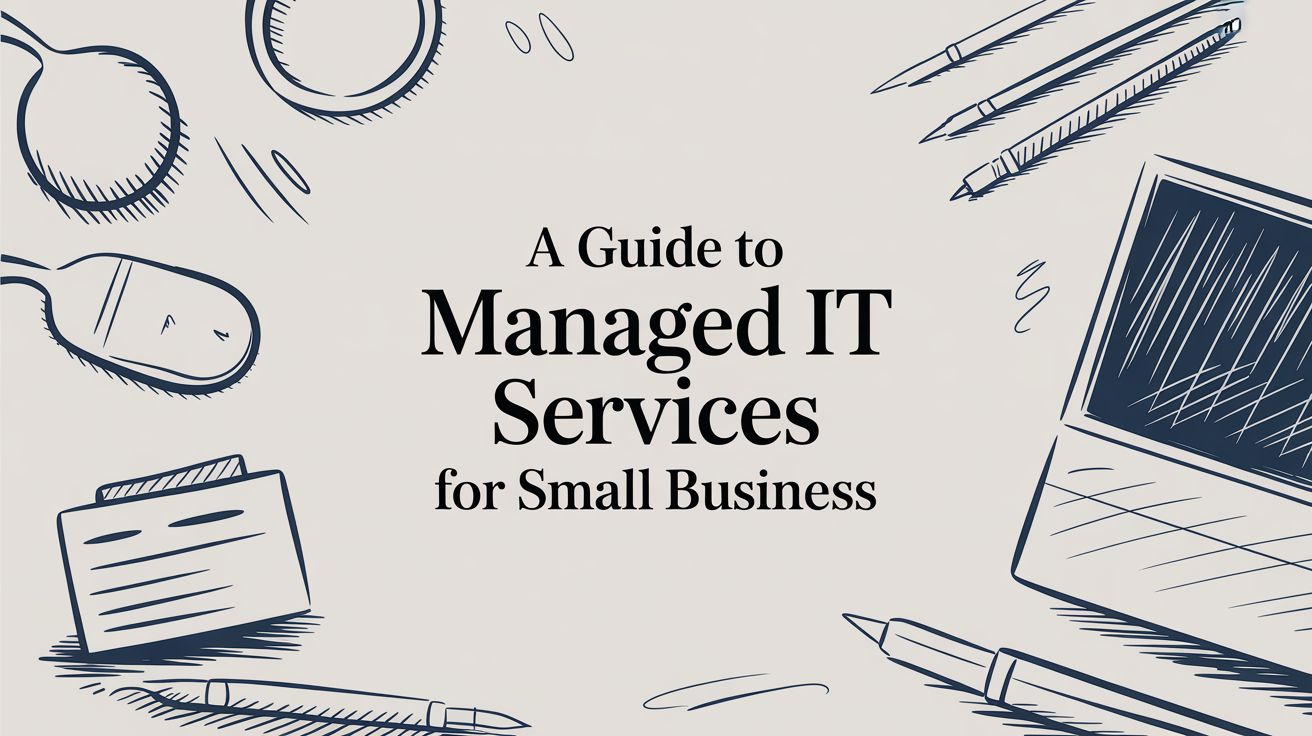
December 30, 2025
A Practical Guide to Your Disaster and Recovery PlanBuild a resilient disaster and recovery plan with our guide. Protect your business from downtime with actionable strategies and real-world examples.
Read Full Post%20(1).webp)
Usman Malik
Chief Executive Officer
April 5, 2024

In the vast landscape of Information Technology (IT), where innovation is constant and change is inevitable, the need for effective project management becomes paramount. Whether you're spearheading a software development endeavor, implementing new technologies, or overseeing system upgrades, mastering the art of project management is essential.
This definitive guide aims to demystify IT project management, explore methodologies, outline key roles, address challenges, and offer tips for success.
At its core, project management is the process of planning, organizing, and executing tasks to achieve specific goals within a defined scope, budget, and timeline. It involves coordinating resources, managing risks, and ensuring stakeholder satisfaction. What sets project management apart is its structured approach, which enables teams to navigate complexity and achieve objectives efficiently.

Envision yourself embarking on a new project, starting from scratch. Project management isn't solely about ticking off tasks; it requires laying a solid foundation before diving in.
The project management institute (PMI) delineates five essential stages for effective project management.
Contrary to popular belief, the initial step in project management isn't planning. Before strategizing, obtaining stakeholder buy-in is imperative. Enter the project charter, delineating the project's business objective for endorsement. However, opting for a project poster streamlines this process, offering a more digestible format. During this phase, pivotal questions must be addressed:
What's the business rationale behind this project? Utilize our strategic plan template for guidance. Is the project feasible? Is it worth pursuing? Essentially, this stage entails determining the project's viability before investing considerable effort.
Conducting a premortem can facilitate discussions by envisioning potential pitfalls and devising preventive measures.
If the decision to proceed is made, the planning stage ensues. Here, a comprehensive project plan, embraced by the entire team, is crafted — a gesture much appreciated by all involved. Planning is paramount to forestalling scope creep. Our to-do list template comes in handy. Key queries addressed during this phase include:
What's the project's overarching goal? Which Key Performance Indicators (KPIs) are pertinent? What constitutes the project's scope? What's the budget? What risks are involved? Who are the team members? Which tasks are involved? Which milestones must be achieved?
This step ensures unified expectations among team members before embarking on the project. Strategic planning frameworks are invaluable aids in this process.
Armed with coffee and determination, it's time to roll up your sleeves and delve into action. The execution stage witnesses you and your team tackling project tasks guided by the project plan. Key actions in this phase include:
Allocating requisite resources Ensuring task assignees fulfill their duties Conducting status meetings Establishing tracking systems The crux of the project unfolds during this phase, marking the realization of your endeavors. Indeed, meticulous planning proves its worth.
Merely possessing a project plan doesn't guarantee seamless progress. Monitoring project advancement is akin to adhering to a budget — having one isn't enough; vigilance is imperative. Hence, monitoring project progress to ensure adherence to the established KPIs is essential.
In case of deviations or scope creep, a reassessment is warranted. This continuous monitoring allows for periodic adjustments, ensuring alignment with the original plan.
The closing stage entails tying up loose ends. Tasks encompass:
Conducting a postmortem or retrospective to evaluate the project, compiling a final project report, and archiving essential project documentation securely, preferably in a collaborative space like Confluence. Apart from providing closure, this facilitates future reference when needed.

While adhering to the aforementioned stages is crucial, effective project management entails additional best practices to ensure smooth project execution.
Even amidst the rigors of project management, remember that you're not alone. Involve your team in the planning process to harness their collective wisdom and bolster ownership of the project's success.
Central to any project is the project manager, the orchestrator of tasks, resources, and timelines. Their role encompasses leadership, communication, and problem-solving to drive success.
Comprising individuals with diverse skill sets, the project team collaborates to fulfill project objectives. Effective teamwork and clear communication are crucial for seamless execution.
Defining the project's scope outlines its boundaries and deliverables. A well-defined scope prevents scope creep and ensures alignment with stakeholders' expectations.
The project plan serves as a roadmap, detailing tasks, timelines, and dependencies. It provides clarity and direction throughout the project lifecycle.

In any IT project, assembling the right team is crucial for success. Each member brings a unique set of skills and expertise to the table, contributing to the project's overall objectives. Let's delve into the key members that typically make up an IT project team:
By bringing together these key members with their diverse skills and expertise, an IT project team is well-equipped to tackle challenges, adapt to changing requirements, and deliver successful outcomes. Effective collaboration, communication, and teamwork are essential for maximizing the collective potential of the project team.

In IT project management, the role of a project manager is indispensable. They are the conductors of the symphony that is project execution, ensuring that all elements harmonize to achieve the desired outcome.
Let’s delve into the multifaceted role of an IT project manager and understand how they contribute to the success of IT projects.
The IT project manager is the central figure in project management, orchestrating every aspect of the project from inception to completion. They are responsible for defining the project scope, objectives, and deliverables, setting clear milestones, and establishing timelines.
At the onset of a project, the IT project manager collaborates with stakeholders to develop a comprehensive project plan. This plan outlines the project's objectives, resources required, potential risks, and mitigation strategies. They ensure alignment between project goals and organizational objectives.
Effective resource allocation is crucial for project success. The project manager identifies the necessary resources, including human capital, budget, and technology, and allocates them efficiently. They optimize resource utilization to enhance productivity and minimize costs.
A skilled IT project manager is a strong leader who inspires and motivates their team to excel. They assemble a diverse team with the requisite skills and expertise for each project phase. Through effective communication and mentorship, they foster collaboration and cohesion among team members.

Navigating through uncertainties is an inherent aspect of project management. The IT project manager identifies potential risks and develops mitigation strategies to preemptively address them. They continuously monitor risk factors throughout the project lifecycle, adapting strategies to ensure project success.
Clear and transparent communication is paramount in project management. The IT project manager is the primary communication nexus between stakeholders, team members, and external partners. They disseminate information, facilitate discussions, and address concerns to maintain alignment and foster collaboration.
In the dynamic environment of IT projects, conflicts may arise among team members or stakeholders. The project manager adeptly navigates these conflicts, employing effective conflict resolution strategies to foster a harmonious work environment. By promoting open dialogue and mutual understanding, they mitigate disruptions and uphold project momentum.
Delivering a high-quality product or service is a cornerstone of IT project management. The project manager establishes quality standards and ensures adherence throughout the project lifecycle. They conduct regular quality assessments, implement corrective measures when deviations occur, and strive for continuous improvement.
Engaging stakeholders and managing their expectations is pivotal for project success. The project manager cultivates strong relationships with stakeholders, keeping them informed and involved in decision-making processes. They address stakeholder concerns, solicit feedback, and seek consensus to drive project outcomes that align with stakeholder interests.
In the ever-evolving landscape of technology, adaptability and innovation are indispensable qualities for an IT project manager. They stay ahead of emerging trends, technologies, and best practices, incorporating innovative approaches to enhance project efficiency and effectiveness.
They embrace change and lead their team through periods of transformation with resilience and agility.

Navigating the complex terrain of IT projects presents its share of challenges. From shifting requirements to resource constraints, IT project managers must overcome obstacles to ensure project success. Common challenges include:
To become a proficient project manager, mastering key aspects is essential. Let's delve into what you need to know:

Various methodologies exist to guide project management practices, each offering distinct approaches suited to different project types and environments. Among the most prominent are:
Emphasizing adaptability and incremental progress, Agile methodologies promote iterative development and close collaboration with stakeholders.
Characterized by sequential phases, the Waterfall approach progresses linearly from initiation to deployment, with each phase building upon the previous one.
Rooted in eliminating waste and maximizing value, Lean methodologies focus on continuous improvement and customer satisfaction.

In the dynamic landscape of IT project management, leveraging the right tools is paramount to ensure efficiency, collaboration, and success. Let's explore some essential IT project management tools that empower teams to navigate the complexities of project execution seamlessly.
Trello is a versatile project management tool that uses boards, lists, and cards to organize tasks and collaborate with team members. Its intuitive interface allows users to visualize project progress, assign tasks, set deadlines, and track milestones effortlessly.
With customizable workflows and integration capabilities, Trello adapts to various project types and facilitates seamless communication and collaboration.
Jira is a robust project management tool widely used in software development projects. It offers powerful features for issue tracking, agile project management, and software development lifecycle management. With its customizable dashboards, scrum boards, and Kanban boards, Jira provides teams the flexibility to manage projects of any scale or complexity.
Integration with other tools and plugins enhances its functionality, making it a go-to choice for IT project management.
Asana is a comprehensive project management tool designed to streamline task management, project tracking, and team collaboration. It offers a user-friendly interface that enables teams to create project plans, assign tasks, set priorities, and monitor progress in real time.
With features like timelines, calendars, and workload management, Asana empowers teams to stay organized and focused on delivering successful projects, regardless of their type or scope.

Selecting the appropriate project management tool is crucial to ensure the success of every project, regardless of its type or complexity. Here are some key considerations:
Different projects follow distinct life cycles, such as waterfall, agile, or hybrid methodologies. The chosen tool should align with the project's life cycle and support its unique requirements, from planning and execution to monitoring and delivery.
Consider the specific processes involved in managing the project, such as task allocation, resource management, and progress tracking. The selected tool should streamline these processes and provide features that enhance efficiency and collaboration.
A good project management tool should be flexible and scalable to accommodate evolving project needs and growing team sizes. It should adapt to changing requirements and scale seamlessly as the project progresses.
Integration with other tools and software systems is essential for seamless workflow management. The chosen project management tool should integrate with popular productivity tools, communication platforms, and development environments to facilitate collaboration and data exchange.
Ease of use and accessibility are critical factors for user adoption. The selected tool should have an intuitive interface, user-friendly navigation, and robust support resources to ensure that team members can quickly adapt to it and utilize its full potential.

Mastering the art of IT project management requires a blend of technical expertise, leadership skills, and strategic thinking. Here are some tips to enhance project success:

Investing in IT project management software offers a myriad of benefits, including:
In conclusion, mastering IT project management is essential for navigating the complexities of technology-driven initiatives. By understanding methodologies, leveraging technology, and fostering effective teamwork, project managers can unlock success and drive innovation in the ever-evolving IT landscape.

Ready to elevate your project management game? Dive into the complete guide to project management with CloudOrbis! Whether you're a seasoned pro or just starting, our comprehensive guide will equip you with the knowledge and tools you need to succeed.
Don't let your projects fall short–embrace the must-have strategies and insights outlined in our guide to craft a clear project roadmap and master traditional project management techniques. Reach out to us today at 905-821-7004 or info@cloudorbis.com to get started!

Project management is the process of planning, organizing, and executing tasks and resources to achieve specific goals within a defined timeframe and budget. It is crucial because it ensures that projects are completed efficiently, on time, and within budget while meeting the desired objectives.
Every project, regardless of its size or complexity, can benefit from effective project management. Whether it's a technology project, construction project, marketing campaign, or event planning, using project management methodologies ensures smoother execution and higher chances of success.
A project management guide provides a structured approach to managing projects, offering valuable insights, best practices, and tools to streamline processes and achieve desired outcomes. By following a comprehensive guide to project management, you can effectively plan, execute, and monitor your next project, increasing the likelihood of success.
The project manager's job is to oversee all aspects of a project, from its inception to completion. They are responsible for defining project objectives, creating a management plan, allocating resources, managing risks, and ensuring timely delivery.
A skilled project manager plays a pivotal role in orchestrating the project team and guiding them toward successful project completion.
Project management software offers a centralized platform for managing tasks, resources, timelines, and communication within a project. By utilizing project management software, you can streamline work management processes, improve collaboration among team members, track progress in real time, and ensure adherence to project timelines and goals.

December 30, 2025
A Practical Guide to Your Disaster and Recovery PlanBuild a resilient disaster and recovery plan with our guide. Protect your business from downtime with actionable strategies and real-world examples.
Read Full Post
December 29, 2025
What Is Business Continuity and Why Your Business Needs ItDiscover what is business continuity and how to build a resilient plan. Our guide covers key components, disaster recovery, and steps for Canadian SMBs.
Read Full Post
December 28, 2025
A Guide to Managed IT Services for Small BusinessDiscover how managed IT services for small business can secure your data, boost efficiency, and drive growth. Learn benefits, costs, and choosing a partner.
Read Full Post